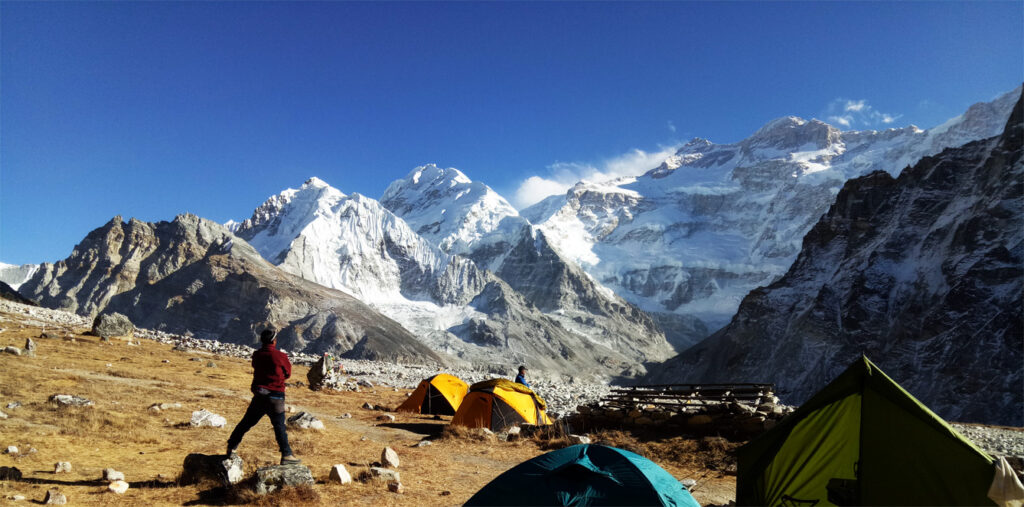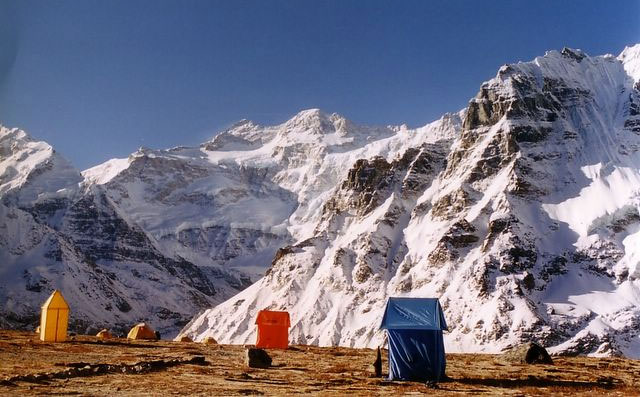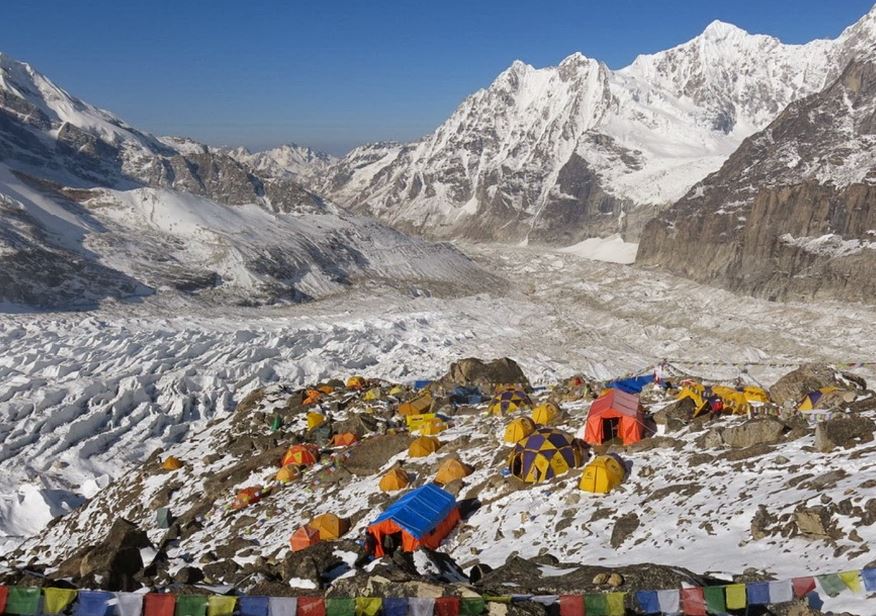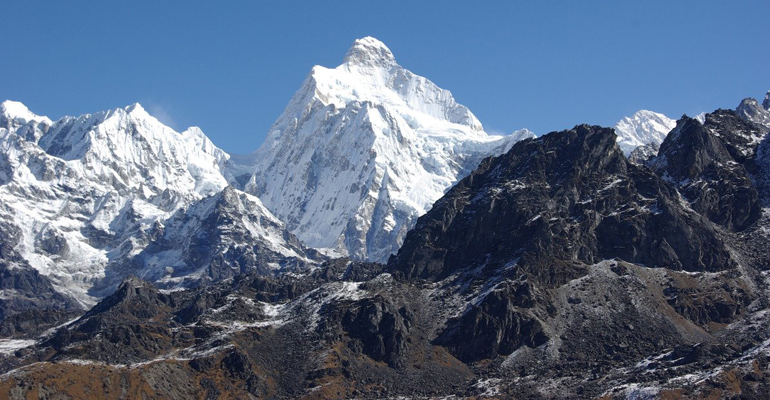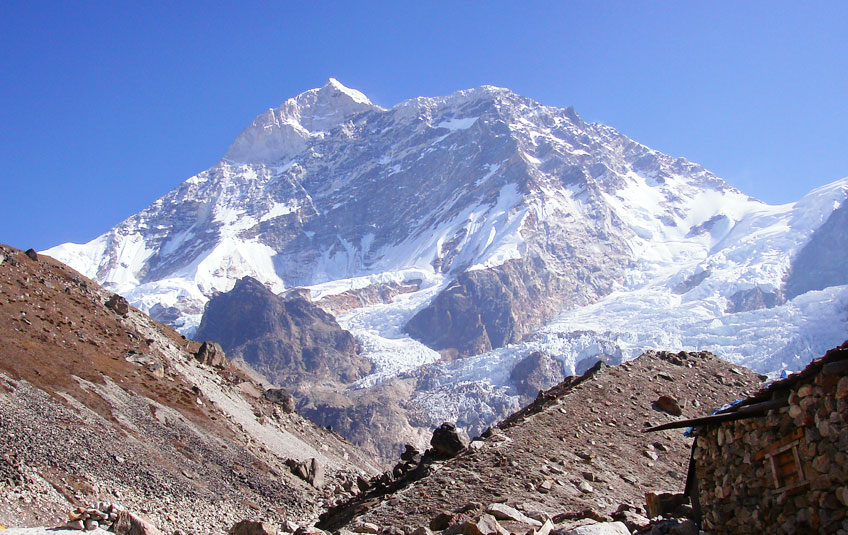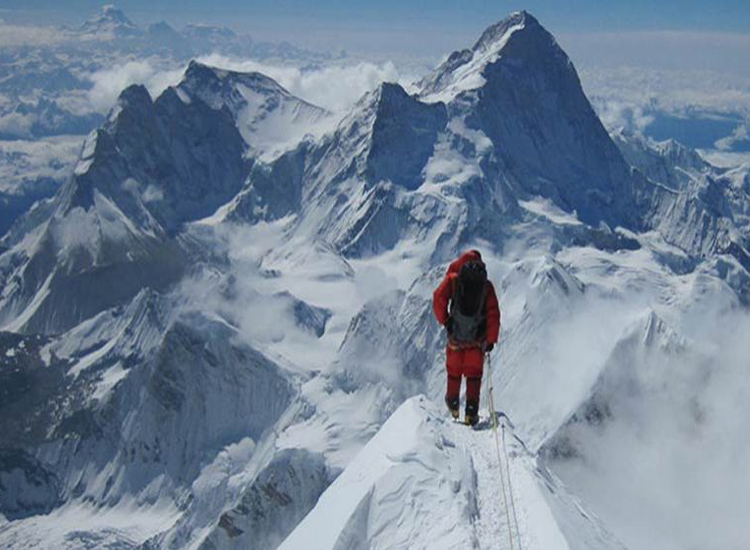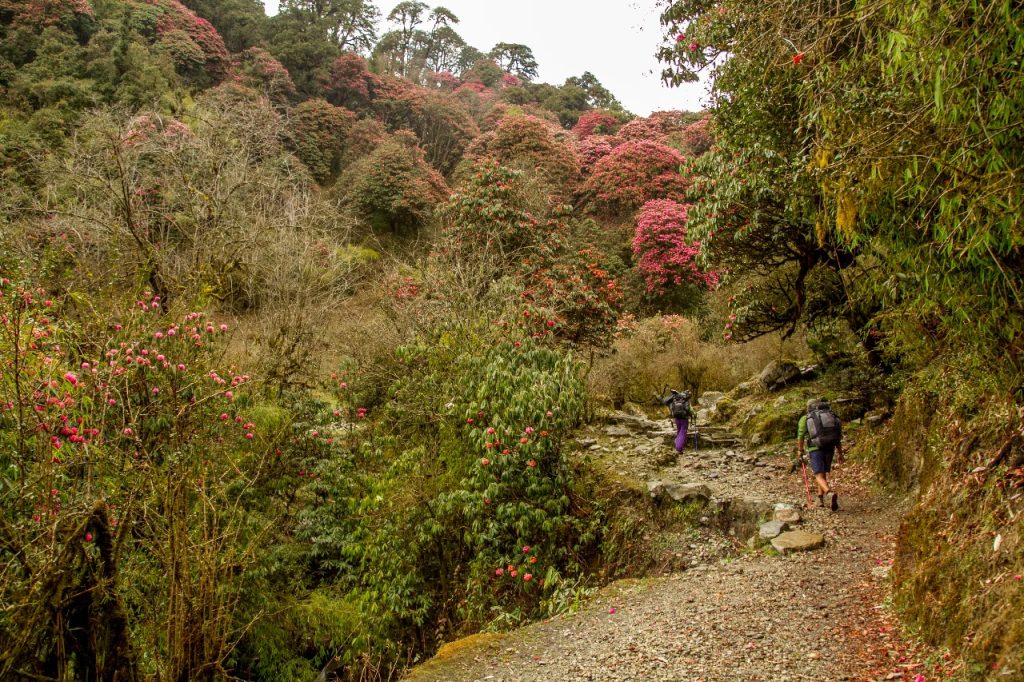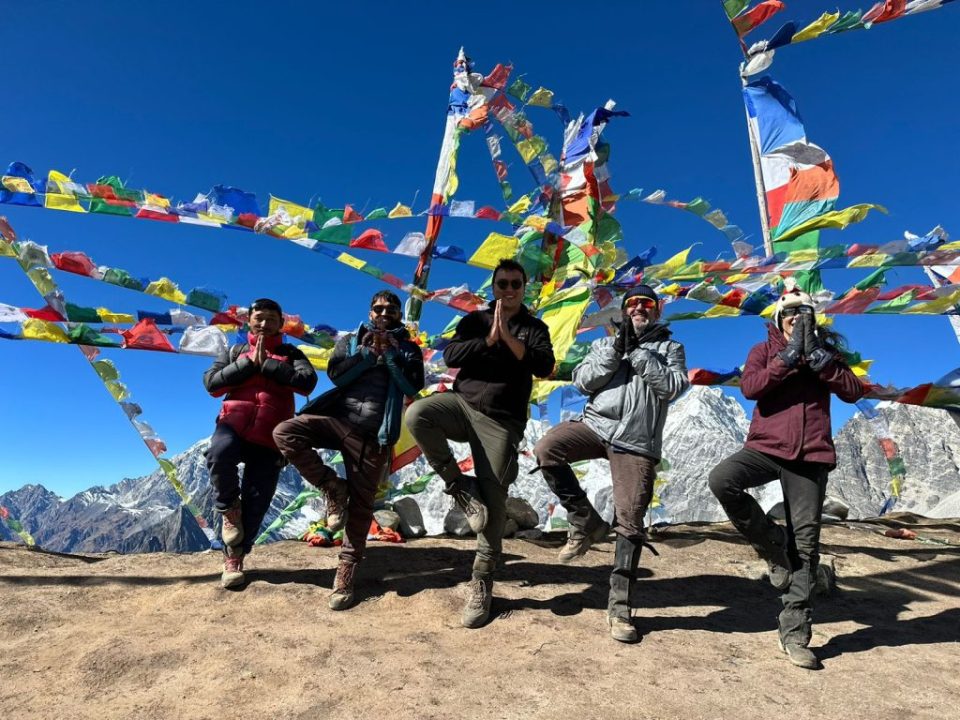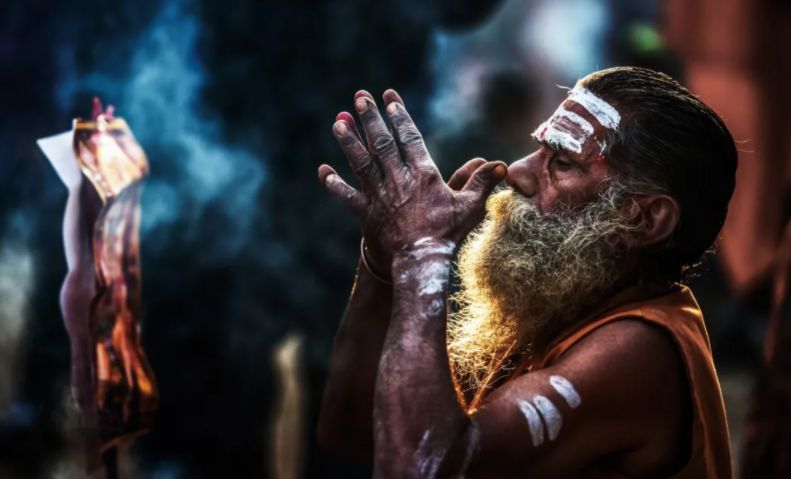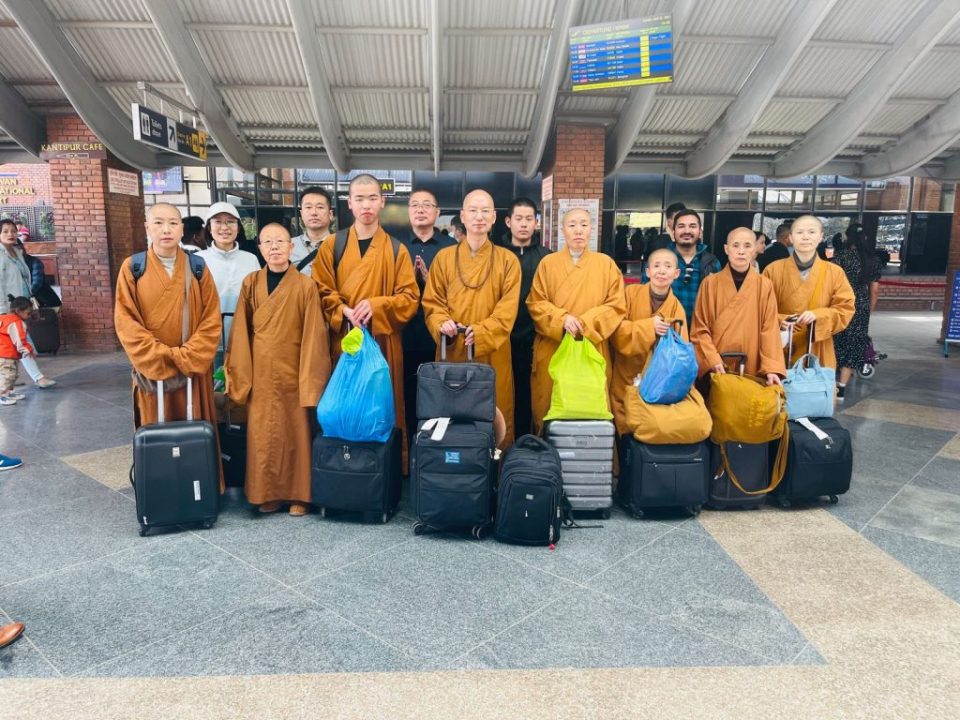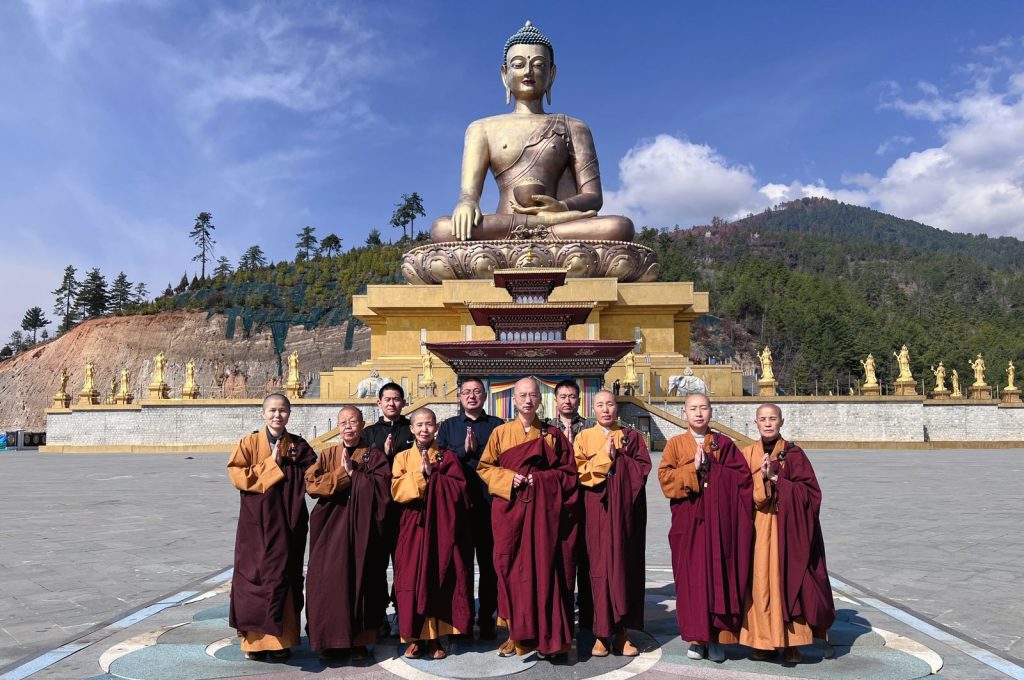Kanchendzonga Base Camp Trek -11 Days
Trip Introduction
Kanchenjunga is also known as Kangchenzonga “The Five Treasures of Great Snow” by the Sikkimese because it has five major peaks. It is the most remote and unexplored trek of India. Kanchenjunga is the world’s third highest peak and Nepal’s second highest peak. It is located in Nepal’s east region. In Nepali, the word Kanchenjunga means “Crystal Clear.” The five major peaks are the Main Summit, South Summit, and Central Summit, which are located in Nepal and India, respectively. West Summit, also known as Yalung Kang, and Kangbachen are the other two peaks that lies in Nepal.
The Kanchendzonga Base Camp is the main highlights of this trek. You will walk on an off-the-beaten trekking path of Kanchenzonga National Park, Sikkim. It is a first “Mixed heritage site” of India that has been listed under UNESCO World heritage site. It was also included in UNESCO Man and the Biosphere programme. This National Park is filled with many endangered animals such as such as blue sheep, snow leopards, black bears, and red pandas. You can also see the Kanchenjunga range, Frey Peak, Koktang, Kabru Peak, Ratong, Chandra Peak and Kabru Dome. You will also be exposed to the cultures of both Nepalese and Sikkimese people.
The 11-day journey begins with a drive to Yuksom, the trek’s starting point. We’ll be on the road for 5 to 6 hours. Along the way, we’ll pass through several beautiful villages, including Tsokha, Dzongri, Lakshmi Pokhari, and Bikhbari. The trail leads to beautiful villages with a diverse range of lifestyles. You’ll be walking through beautiful mountains, waterfalls, and lush green forests. We will travel from Bikhbari to the Kanchenjunga Base Camp, where we will explore and enjoy the breathtaking views of the mountains. We will take the same route back to the trek’s end point, Yuksom.
Trip Facts
| Country | Nepal- India |
| Duration | 11 Days |
| Maximum Altitude | 4,600m/15,091ft |
| Region | Sikkim |
| Meals | Breakfast, Lunch, Dinner |
| Accommodation | Hotel, Lodge, Teahouses |
| Grade | Challenging |
| Best season | Mar, Apr, May, Sep, Oct, Nov |
Trip Highlights
- Explore the Kanchenzonga National Park.
- Pass through amazing George, Mountains, Terraced Farmland, waterfalls, and Monasteries.
- Enjoy the amazing views of the Kanchenjunga range, Frey Peak, Koktang, Kabru Peak, Rathong Glacier, Chandra Peak, and Kabru Dome.
- Walk on the off-beaten trekking path of Kanchenzonga National Park.
- Witness rare animals like blue sheep, snow leopards, black bears, and red pandas.
- Visit the oldest monastery of Sikkim- Dubdi Monastery.
Is this trek appropriate for you?
- The Kanchenjunga Base Camp is the Challenging Trek. You can easily complete this trek if you are physically and mentally prepared and willing to do so.
- You will be Trekking for 8 Days. The Path can be completed in as little as 3 hours as much as 8 hours.
- The walk is not tricky, there is no Climbing or Scrambling but the path is rocky and hilly.
- Each day you will cover 200 to 400 meters in height while trekking. The highest point in the trek you will reach on the trek is 4,600m.
- The weather and Remoteness of this trek, as well as dealing with the high altitude, require a slow pace and the need to stay hydrated.
Itinerary
| Days | Activities | Durations |
| 1. | Arrival at Bagdogra and Train Ride to Yuksom Base Camp (1,780m/5,840ft) | 6-7hrs |
| 2. | Trek from Yuksom to Tsokha (3,050m/1,006ft) | 7-8hrs |
| 3. | Trek from Tsokha to Phedang (3,760m/12,335ft) | 4-5hrs |
| 4. | Trek from Phedang to Dzongri (4,320m/14,173ft) | 4-5hrs |
| 5. | Rest Day at Dzongri and Hike to Lakshmi Pokhari (4,030m/13,221ft) | 3-4hrs |
| 6. | Trek from Dzongri to Bikhbari (3,840m/12,598ft) | 5-6hrs |
| 7. | Trek from Bikhbari to Chaurikhang to Khangchendzonga Base Camp (4,600m/15,091ft) and return back to Bikhbari | 4-5hrs |
| 8. | Trek from Bikhbari to Bakkhim (2,750m/9022ft) | 5-6hrs |
| 9. | Trek from Bakkhim to Yuksom (1,780m/5,840ft) | 5-6hrs |
| 10. | Drive from Yuksom to Bagdogra (136m/446ft) | 6-7hrs |
Itinerary
Departure from : Kathmandu, Nepal
Arrival On : Kathmandu, Nepal
Day 1
Arrival at Bagdogra and Train Ride to Yuksom Base Camp
When you arrive at Bagdogra airport, our representative will assist you to the NJP train station, where you will wait for your train and rest and relax until it arrives. You will also meet up with other team members such as guides and porters. It will take approximately 6 to 7 hours to travel by train. Dinner and Overnight at the Lodge.
Day 2
Trek from Yuksom to Tsokha
We’ll leave for Tshoka after breakfast. We’ll be walking for 7 to 8 hours. We’ll gradually climb the hill next to the Rathong River Gorge then walk through a forest filled with Rhododendrons, pines, and oaks. We will also see various plant species such as ferns, orchids, and colorful birds. Following the forest, we’ll then cross Paha Khola Bridge, where there is a waterfall where we can swim. On the way, we’ll stop for lunch. We’ll cross the Prek Chu River and walk toward Bakhim village. From there, we’ll walk for about an hour to Tshoka Village, a Tibetan refugee settlement. Dinner and Camp at Tsokha.
Day 3
Trek from Tsokha to Phedang
We’ll leave for Phedang after breakfast. We’ll be walking for 4 to 5 hours. We will gradually ascend above the Tshoka. We’ll be walking through a Rhododendron Forest. We’ll enjoy the trail as we take in the breathtaking scenery. We’ll stop for lunch on the way. We’ll continue climbing uphill until we reach Phedang. Dinner and Camp at Phedang.
Day 4
Trek from Phedang to Dzongri
Leave for Dzongri after breakfast. We walk for 4 to 5 hours. We will walk slowly because we are at a higher altitude. We must properly acclimate to cover a short distance. We will walk along a beautiful trail with stunning views. We’ll stop for lunch on the way and then continue to Dzongri. We will prepare to pitch the tent and rest. Dinner and Camp at Dzongri.
Day 5
Rest Day at Dzongri and Hike to Lakshmi Pokhari
If you want to see the beautiful sunrise on Khangchendzonga, you can get up early and climb a hill to reach a viewpoint. You can both enjoy the breathtaking view or rest and start your day a little later. You’ll be exploring Lakshmi Pokhari later, so leave after breakfast. You’ll be walking for 3 to 4 hours. We’ll walk through Rhododendron Forest and pasture land to get to Chamaray. We will then ascend to the Lakshmi Pokhari, where there is a large lake. We will take in the scenery, which includes the Khangchendzonga range, Pandim, Narsing, Kabur, Kabur dome, and Koktang. Return to Dzongri. Dinner and Camp at Dzongri.
Day 6
Trek from Dzongri to Bikhbari
We’ll leave for Bikhbari after breakfast. We’ll be walking for 5 to 6 hours. We will gradually ascend and walk, then descend until we reach a crossroads. Throughout the trail, we will take in the scenery. We’ll stop for lunch on the way. Having lunch, we will descend on the trail to Zamlingang then continue on the flat trail on the right-side, until we reach Bikhbari. Dinner and Camp at Bikhbari.
Day 7
Trek from Bikhbari to Chaurikhang to Khangchendzonga Base Camp and return to Bikhbari
We will depart for Khangchendzonga Base Camp after breakfast. Today we will be walking for 4 to 5 hours. After a short ascent up the hill from Bikhbari, we will reach Chaurikhang. Taking advantage of the path’s secrecy, walk slowly because we are at a higher altitude. We have to climb up the hill until we reach HMI’s (Himalayan Mountaineering Institute) Advance camp- the Khanchendzonga Base Camp. With the hours of the uphill climb, we’ll arrive at the base camp. Explore the area, take in the breathtaking views of peaks such as Frey’s Peak, Koktang, Kabur, and Rathong Glacier. We rest for a while before returning to Bikhbari. Dinner and Camp at Bikhbari.
Day 8
Trek from Bikhbari to Bakkhim
We’ll leave for Bakkhim after breakfast. We’ll be walking for 5 to 6 hours. We’ll take the same path back to Bakkhim. We’ll be going on a walk through a Rhododendron Forest. We’ll enjoy the trail while taking in the stunning scenery. We’ll eat our lunch on the way. We’ll continue on our way to Bakkhim. Dinner and Camp at Bakkhim.
Day 9
Trek from Bakkhim to Yuksom
We’ll leave for Yuksom after breakfast. We’ll be walking for 5 to 6 hours. We’ll take the same path back. We will then cross the Paha Khola Bridge to a waterfall where we can swim. We’ll be walking through a Rhododendron, Pine, and Oak Forest. We will also see ferns, orchids, and colorful birds, among other plant species. We’ll eat lunch on the way. Having lunch, we will then trek to the oldest monastery of Sikkim- Dubdi Monastery (the hermit’s cell), which is on the top of a 1000ft. lofty hill. You will get to see the amazing view of mountains in its background. Exploring the monastery, we will continue down to the Yuksom. Dinner and Overnight at the Lodge.
Day 10
Drive from Yuksom to Bagdogra
After breakfast, we will depart for Bagdogra. We’ll be on the road for 6 to 7 hours. We’ll take in the scenery on the way. We’ll stop for lunch on the way. When you arrive in Bagdogra, our representative will help you with the hotel check-in process. We will then depart from you. You can tailor your drop-off location to your preferences if you wish. Dinner and Overnight at the Lodge.
Route Map
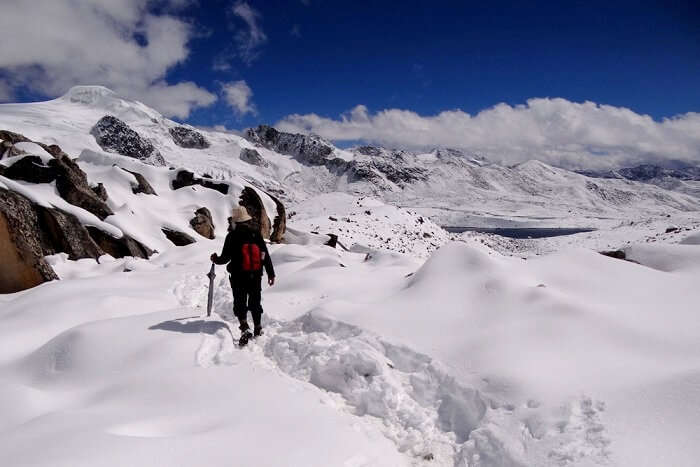
Altitude Map
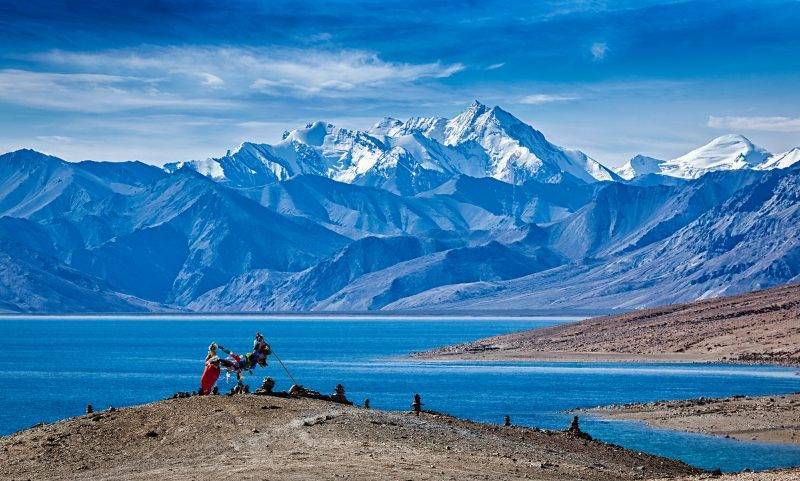
What's Included
- Arrival & Departure: Airport – Hotel transfer – Airport (Pick Up and Drop on private basis).
- Hotel Accommodation in Yuksom: 2nights at Star categories hotel on Twin sharing and BB basis.
- Welcome Dinner and farewell dinner at a restaurant in India.
- Food & Lodging: 3 meals a day (Breakfast, Lunch, Dinner) along with accessible accommodation sharing during the trek.
- All government and local taxes if necessary.
- Permit: All necessary paper works: ILP or Restricted Area Permit and Kanchenjunga National Park Permit.
- Trekking Map.
- Member transportation: – Air Transportation: Flight to Bagdogra and while returning.
- Railway Transportation: From Bagdogra to Yuksom and while returning.
- Drinking: A mineral water bottle per person per day during the trek.
- Guide: Government licensed Guide (English speaking) during the trek
- Porter: Porters (2 trekkers: 1 porter) up to 15kg during the trek.
- Insurance of all involved staff.
- Comprehensive Medical kit.
What's Not Included
- Air Fare: International flight airfare.
- Tourist Visa fee.
- Extra nights’ accommodation in India. In case of early arrival or late departure, early return from Trekking (due to any reason) than the scheduled itinerary.
- Personal Insurance: Travel and high altitude insurance, accident, Helicopter medical & emergency evacuation. *Mandatory
- Personal Expenses: Telephone calls, Internet, Toiletries, battery recharge, hot shower, laundry, soft drinks, beer, and any alcoholic beverages.
- Personal Equipment: Clothing, Packing Items or Bags, Personal Medical Kit, Personal Trekking equipment.
- Rescue Evacuation: Medical and emergency rescue evacuation costs if required. (Rescue, Repatriation, Helicopter, Medication, Medical Tests and Hospitalization costs).
Equipment List
What to bring ?
General
Tailor Your Holiday
Everyone has their own preferences in terms of destination, journey time, and budget. As a result, sticking to our plan isn't necessary. We will create a personalized itinerary for you that includes accommodations, transportation, meals, and tour guides. We guarantee you the best Tailor-made Package because this is your trip. You have the option to personalize it, as your liking. Let us Plan together to make your Vacation worth it.
Fixed Departure
Why Travel With Us?
The ideal season to travel
Spring
March: The month of March is ideal for trekking and admiring the spectacular mountain peaks. The Kanchenjunga Base Camp trekking trail will be crowded with hikers beginning in March. In the Kanchenjunga Base Camp region, the spring season begins in March, the month of the Rhododendron. Trekking in March will provide you with the most memorable experiences in a pleasant and mild climate. At lower altitudes, the weather is not particularly hot, and at higher altitudes, it is not particularly cold. The views of the mountains are spectacular, and the trail is excellent. Nature can be experienced at its most beautiful.
April: April is the beginning of spring in Nepal, and the weather is ideal for trekking to Kanchenjunga Base Camp Region. The views are bright and clear at this time of year, and everyone enjoys spring. The surroundings are vibrant and colorful, with rhododendrons in bloom. It is the best time of year to see various bird and butterfly species. During your April trip to Kanchenjunga Base Camp l, the weather is completely in your favor. The moderate heat of the sun, combined with the lack of wind, makes it ideal for trekking. Furthermore, the amount of rain and snow is insignificant.
May: May, the final month of the spring season in Nepal, is much hotter. The Kanchenjunga Base Camp Region trek in May has the highest temperature of the year. Temperature and weather will vary depending on the altitude throughout the trek. During the day, the weather in the lower sections will be extremely hot. The nights, on the other hand, are tolerable.
Summer
June: June is the coldest time of the summer and has the least amount of rainfall. The month of June is the offseason and therefore less popular for trekking. In the region, June marks the start of the wet monsoon season. The weather is slightly humid, and you can enjoy nature while it is wet and cool. If you enjoy the rain, rainbows, and less crowded trails, this is the month for you. During this month, the air begins to become humid due to continuous rain.
July: Trekking in Nepal in July isn’t always joyful because the heavy rains can block your view of the beautiful mountains you’ll pass through. In July, you will notice that the temperature is not as chilly in the Kanchenjunga Base Camp Region. As the rain washes away the dust and pollution, the environment opens up and becomes very fresh, and you will be able to enjoy nature despite the chilly weather.
August: In the Kanchenjunga Base Camp region, August is the off-season for trekking. In August, the monsoon season produces strong rains, especially in lower places. Due to weather-related concerns, most hikers avoid this month. The summer monsoon season comes to an end in August. It rains regularly, and you may feel a little chilly as a result. You should also be cautious because the trails are slippery and the possibility of landslides and avalanches is considerable.
Autumn
September: The monsoon season finishes in September, marking the start of the fall season. The optimum time to trek to Kanchenjunga Base Camp Trek is in September. The weather and temperature for the Kanchenjunga Base Camp Trek are ideal. The temperature is pleasant during the day, but it is extremely chilly at night.
October: October is the month that falls between September and November. As a result, it keeps both monsoon rain and winter’s biting cold at distance. The weather is warm and pleasant in October, with clear skies and fresh air. The nights, on the other hand, are a little chilly, with a brisk breeze coming from the campsite. Throughout October, the weather is pleasant, allowing people to enjoy an unobstructed view of the snow-capped peaks. They can also visit bright valleys and interesting scenery of various colors.
November: The last declared peak season for trekking in Nepal is November. Bright, sunny days and beautiful skies characterize November. On the treks, these provide breathtaking, crystal-clear vistas of the mountains. The days are bright and sunny in November. The sky is clear, with perhaps a few stray clouds possible.
Winter
December: In the Kanchenjunga Base Camp region, December is a rather dry month. It receives fewer than 25 millimeters of rain every year. The Kanchenjunga Base Camp is in the shadow of the Himalayas. As a result, December has a lower chance of rain. It is also possible to walk the Kanchenjunga Base Camp Trek in December. In December, hikers will get a unique perspective of the region.
January: In Nepal, January is in the midst of winter. The higher elevation receives moderate snowfall, whereas the lower elevation is ideal for trekking. During the day, you will feel warm, but as night falls, you will feel cold. In January, these areas receive little to no rainfall. As a result, the skies remain clear and the surroundings appear even sharper. The trails will be covered in snow, so you may need crampons to cross the pass.
February: The Kanchenjunga Base Camp Region trek in February is an escape from the hustle and bustle of everyday life to a place where all you can see are mountains and scenery. It’s peaceful because February is the coldest month of the year. Most people dislike trekking in the winter because they believe it is extremely difficult.
Train to Yuksoom
- Yuksoom’s nearest station is New Jalpaiguri in Siliguri, West Bengal.
- It is approximately 153 kilometers from Yuksoom.
Altitude sickness
Beyond 2,500m (8,000ft), Altitude sickness is a sneaky monster that may attack even the fittest trekkers. These demands do everything in your power to prepare for altitude trekking and take things carefully throughout your Kanchenjunga Base Camp journey. With increasing altitude, the amount of available oxygen decreases, which is the primary cause of high-altitude sickness.
So, you may suffer from different altitude sicknesses at an altitude of 4,600m.
i.e., Acute Mountain sickness (AMS), High pulmonary edema (HAPE), High-altitude cerebral edema.
Your body requires time to adjust to thin air, so start at a lower altitude and work your way up. Some of the symptoms of Altitude sickness are:
- Increased breathing.
- Increased urination.
- Restless sleep.
- Periodic breathing at night because of altitude.
- Dehydration.
- Shortness of breath.
- Extreme fatigue.
- Respiratory failure.
- Cerebral edema.
- Coma.
Certain care should be made to ensure that the situation does not worsen. However, if the symptoms worsen, you may need to return to a lower height and seek medical help. There are, however, several other precautions you may take while trekking to Kanchenjunga Base Camp to lessen your risk of altitude sickness.
- Trekkers can modify their bodies by slowly and gradually climbing, as our bodies require time to adjust to the oxygen level. For high altitude trekking, at least one day of acclimatization rest is essential, and you should ascend as high as possible before returning to a lower altitude for the night.
- You should do various strength training exercises such as running, cycling, jogging, push-ups, and go to the gym to acquire strength and stamina for your adventure.
- As the air gets increasingly thin, an increase in elevation reduces oxygen levels, and in the Everest region trek, an increase in altitude also means less vegetation. The consumption of alcoholic beverages, cigarettes, and tobacco decreases the body’s water content.
- The greatest remedy is to always stay hydrated. On your walk, instead of drinking cooled water, drink warm water.
- Diamox is the most effective altitude sickness medication; thus, you should bring a subscription with you on the trek. However, you should consult with your physician to see whether it is advantageous.
Things to know before traveling to Kanchendzonga Base Camp.
Drinking-Water.
Trekkers must hydrate their bodies at a higher altitude than in lower elevations to avoid dehydration and altitude sickness. Lack of fluid can be the main hindrance during the trek. You should hydrate your body with at least 3-4 liters of water daily (Tea, soup, or normal drinking water).
Few River water resources are available in the trek to Kanchendzonga Base Camp but are not safe to drink. You are not used to the local water, so drinking it may result in Diarrhoea. However, if you are refilling your bottle with river water, treat it with purifying tablets or a water filter (Steripen) before drinking.
Besides that, the only places to get drinking water are lodges/teahouses, so whenever you get to any teahouses/lodges on the trail grab the opportunity to refill your water bottle and treat it before drinking. The teahouse also provides boiled drinking water. Coldwater is provided free of charge, but for boiled water, you have to pay a certain amount. Plastic water Bottles and Polystyrene are banned throughout the state.
Every day, you must carry enough water for the day before beginning the trek because in someplace you might won’t find any water resources on the trail. We recommend you bring a Reusable water bottle of 2-3ltr or a water pouch favorable for both hot and cold water.
Here are some ways that you can use to make the water drinkable.
- Boiled water
Boiling water is the best way to purify the water. As we are climbing to a higher altitude you need to boil the water for about 3-minute and season it with a pinch of salt before drinking. You can get free tap water in the teahouse/guesthouses but for boiled water, it cost a certain amount.
- Purification tablets or electrolyte powder.
Purification tablets like chlorine or iodine tablets are commonly used tablets by trekkers to disinfect the water. 1 tablet is enough for a liter of water. It takes around 30 min for the tablets to dissolve and become drinkable. Water purified by tablets may leave a taste in your mouth.
Electrolyte powder is another option. Electrolyte powder is a better way to purify water than tablets because electrolyte powder contains minerals such as salt, Potassium, Magnesium, which are important for your body during the trek.
- UV Light water purifier/ SteriPEN.
It is a simple, effective, economic, and environment-friendly way to purify water. It kills the bacteria and virus within 10 sec by exposing them to ultraviolet light using Steripen, without changing the flavor of the water. This is a highly recommended means of purifying water (a one-time investment).
Electricity and Internet facility.
Electricity facility.
In this trek to the Kanchendzonga Base Camp of India, you won’t be in darkness. Either the area will be powered by hydroelectricity or solar power lights/batteries.
The lower area is powered by local hydroelectricity so there will be a charging socket in your hotel/lodge’s rooms and you will have no problem with electricity. However, as you climb higher, the area relies on a Solar panel or solar power battery for electricity that is enough to light the bulbs and charge small devices. And there will be no charging socket in your room. There is a commonplace for charging usually in the dining area. You might be able to charge a normal mobile set, camera battery, and power bank from the solar power battery/generator. Some allow it for free while some will charge a certain amount. Solar battery power might harm your device, so charge it at your own risk. As a result, it is recommended that you bring a power bank and a spare camera battery.
Internet Facility and Network Service
Only in the lower area in this trek, you will have Wi-Fi/internet access. However, check with each teahouse/lodge where you’ll be having lunch or staying overnight, if they have Wi-Fi, if you’re lucky, enjoy the Wi-Fi. Some provide it free of charge while some charge an amount. But as you climb to higher altitudes, the other way to connect by the internet is via. your cellular network’s data package.
There are many telecommunications services in India, such as Vodafone, Airtel, Jio, BSNL, however, Airtel telecommunication service is a highly preferred network over other networks. It has a stable signal range. With the Airtel 4G service, you will be connected during your journey. Buy the Airtel 4G sim card from the stores in any store at Yuksom. By taking data packages you can use the cellular and internet service up to Kanchenjunga base camp. A satellite phone can be the best option for calls. If possible, less usage of a device with Low brightness, Wi-Fi and GPS off, and Airplane mode.
Document needed to buy a sim card.
For Foreigner = 1 passport size photo, Passport photocopy, or valid identity card.
Essential Backpack items for Kanchendzonga Base Camp Trek.
The bag of a trekker also reveals the trekker’s level of experience. A good trekker should be a smart backpacker. You should be pre-prepared for the things that you need in the trek. As this trek is in a remote area, there won’t be any shops once you start your trek, so need to bring enough supplies that you need in the trek.
Here are some of the things that you need to take with you for the trek.
Travel documents
- Airline tickets with the itinerary.
- Travel insurance policy documents.
- Original valid passport.
- Copies of passport.
- Passport-sized photos.
- Indian cash.
- Travel permits.
Clothing
- A pair of waterproof trekking shoes or hiking boots.
- A pair of flip flop slippers or running shoes.
- 2-3 Sets of thermals (leggings and tops)
- Pairs of hiking long sleeve shirts or tops.
- Pairs of hiking shorts and pants.
- Fleece jumpers or a set of tracksuits.
- Good quality windproof down jacket.
- Lightweight waterproof rain jacket and pants.
- Neck gaiter, leg warmer, and a packet of pocket hand warmers.
- 5-6 pairs of quick-dry socks, underwear, sports bra.
- Pair of inner and outer gloves.
- Knitted Hat, sun cap, beanie, or bandana.
- Glacier Sunglasses and eyeshade.
Trekking equipment
- Waterproof trekking bag of 40-50liter and Rucksack of duffel bag (if your backpack is not enough for all your item and need a potter).
- Reusable water bottle (both hot and cold) of at least 2-3litre.
- A sleeping bag and sleeping bag liner.
- Trekking stick/ poles.
- Route Map.
- Crampons (if you are trekking in the Winter season, Dec-Feb).
- LED Headtorch or solar lamp.
- Stuff sacks, paper bags.
- Plug adapter, Charging appliances, Power bank, Camera batteries.
- Pocket knife.
- Travel Wallet.
Toiletries
- Rolls of Toilet paper, wet wipes, and tissue.
- Medium-sized quick-drying towel.
- Toothbrush and toothpaste.
- Hand sanitizer.
- Sunscreen, lip balm, body lotions.
- Deodorants.
- Portable mirror.
- Shampoo and soap.
Personal First Aid Kit
- Antibiotics
- Painkillers, Paracetamol, ibuprofen, aspirin, Nicole
- Sanitary pads
- Bandage.
- Anti-inflammatory spray.
- Anti-Nausea tablets.
- Anti-diarrhea pills or power.
- Altitude sickness tablets- Diamox
- Water purifying tablets or electrolyte powder.
- Mosquito and Insect Repellent.
- Salt or anti-leech oil (If traveling in the rainy season, July- Aug)
- Earplugs
You can buy or hire trekking clothes and equipment in Bagdogra, Siliguri- Yuksom, Sikkim. If you are buying it, you have to allow an extra day for shopping; however, if you are hiring it, you must inform us in advance so that we can arrange it before you arrive in Sikkim. This way you can reduce the weight of your luggage and save time and money.
Branded, New as well as fake and used trekking clothes and equipment are available around Siliguri- Sikkim at a reasonable price.
Accommodation, Meal, and Transportation
Accommodation
We will accommodate in a star hotel in Yuksom.
During the trek, we will accommodate in Lodges/ Teahouses, mostly in Camp.
Meal
During the trek, we will provide you three-time meals. You can choose from the given menu.
Breakfast– French toast, Bread butter, Boiled egg, Omelets, Porridge, Tea, etc.
Lunch– Dal Bhat set (Rice, Vegetable curry/ Meat curry, Lentils, Pickle, Salad), Fried rice, Chowmein, Noodle soup, Garlic soup, Noodles soup, Mo: Mo (dumplings), etc.
Dinner– Dal Bhat set (Rice, Vegetable curry/ Meat curry, Lentils, Pickle, Salad,), Fried rice, Chowmein, Noodle soup, Garlic soup, Noodles soup, Mo; Mo (dumplings), etc.
These are the options of food that you will find mostly on the trek.
Transportation
By Air– Flight from – to Bagdogra and returning.
By Train- From Bagdogra to Yuksom and returning.
Guide and Staff Arrangements
Throughout the trek, all your activities will be handled by our well-qualified and professional staff. They will do all the escorting. As this is one of the tricky treks, we are providing you with a highly experienced and licensed guide with fluent English speaking and has excellent navigation. They will accompany you from Bagdogra and guide you throughout the journey to Kanchendzonga Base Camp. Each group of 4-5 trekkers will be assigned an assistant guide, as well as a porter for two trekkers (2*15kg =30kg). If your luggage weighs more than 15kg you will be provided a porter individually but you will be charged extra.
All our lead guides, assistant guides, and potters are well professional and experienced. So, we hope for your respect and cooperation with them throughout the trek.
A typical day on the Kanchenjunga Base Camp trek.
Every day will begin with the ringing of your alarm clock at 6 a.m. and a knock on your door from your guide with the invitation of breakfast. Get up, have breakfast, pack your backpack and get ready to start your day’s walk by 7 a.m. You need to start your trek early to avoid the scorching sun and to reach your overnight destination on time/ before dawn.
You’ll walk along the dense forest; clicking photos; creating memories; interacting with your guide; hearing each other’s stories. Lunch will be served in the afternoon. Having the flavorful lunch and an hour of rest, we will proceed to the day’s final destination as per the itinerary.
On arrival at the destination, check into your accommodation. Get freshen up and some rest. Most of the place, where we stay has a common dining area with a heater, there you will get to meet other travelers. You can sit there, laugh at each other stories, play cards, sing songs, play music, and have a good time. This will help you forget all the tiredness of the day. Later in the evening, you will have your dinner together. After dinner, your guide will give some short briefings about the next day’s trek regarding when you must get up, when we have to start our trek the next day, where we will stay the next day, how many hours we have to walk and so on.
During this 8-day trek to Kanchenjunga Base camp, you will walk for a minimum of 4 hrs to a maximum of 8 hrs in a day. You will have a scenic flight to Bagdogra, before starting and ending your trek. Then you will have a train ride to Yuksom from where your trek starts. You will walk on the off-beaten rocky path over the dense forest of Kanchenzonga National Park. During this trek, you pass through the amazing dense forest, snow-covered mountains, George, Passes, and villages. You will stay a night near HMI Advance Camp (Himalayan Mountaineering Institute). Admiring the view of Kanchenjunga range, Frey Peak, Koktang, Kabru Peak, Rathong Glacier, Chandra Peak, Kabru Dome, and the mesmerizing beauty of Kanchenzonga National Park, you will complete the Kanchenjunga Base Camp trek. Every stop along the way will be a wonderful day. Your hard walk will be paid off when you complete the trek with unforgettable memories that will last for a lifetime.
India Tourist Visa and permits details
Visa procedure.
To travel to India, you’ll need a tourist visa that is valid for the period of your stay in India. Better, you have a tourist visa valid for at least 1 month because anything can happen during the trip, and staying in India after your visa expires would result in you paying a penalty. Apply for a tourist visa at your nearest Embassy of India.
Here are the documents that you need, to apply for the tourist visa.
- Duly filled Tourist Visa Application Form for India.
- Original Passport with at least 2 blank pages and a minimum validity of at least 6 months.
- Old passport (in case you have)
- Photocopies of your passport’s information page.
- Recent passport-sized photo (not less than 3 months) of yourself with white background.
- Copy of proof of Residence: National Id Card and latest Utility bill (not less than 6 months old)
- Proof of profession: Certificate from the employer. If student, copy of Id Card from the educational institute and for a retired person, copy of retirement papers.
- Valid travel and return flight tickets.
- A bank statement from the last 3 months and endorsement of foreign currency equivalent to US$ 150 per applicant (endorsement should not be older than 1 month), International credit card with running year endorsement in the passport.
- Proof of accommodation in India.
- Receipt of the tourist visa fee of India.
Entry permits and Requirements
Kanchenjunga Base Camp, Sikkim is a protected area that lies under the Kanchenzonga National Park, so you have to obtain some special permits from the Government of Sikkim to trek to Kanchenjunga Base Camp. The Entry permits that you need for the trekking to Kanchenjunga Base Camp are;
| Permits | Foreign Nationals | SAARC nationals | Students
(Indian Nationals) |
|
| 1. | Restricted Area Permit/ ILP (Inner Line Permit) | Free of cost. Just need a passport-size photo and photocopy of the passport personal information page. | -N/A | -N/A |
| 2. | Kanchenzonga National Park Entry Permit. | INR 560 per person for the first week.
INR 80 per person per day beyond 7 days. |
INR 350 per person for the first week.
INR 40 per person per day beyond 7 days. |
INR 80 per person for the first week.
INR 20 per person per day beyond 7 days. |
| 1. | For local guide and Porter.
Ten Pitching Charge Bed charge in Log hut. |
INR 10 per person per day.
INR 50 per tent per day. INR 100 per bed per day. |
Note– Inner Line Permit/Sikkim Restricted Area Permit can be obtained, outside the Bagdogra Airport at Sikkim Tourism Counter or the Forest check post at Yuksom, Sikkim. Kanchenzonga National Park Permit can be obtained from the entrance gate of Kanchenzonga National Park.
Trekkers cannot travel in this area- Kanchenzonga, without a permit and guide.
(If you are traveling from a travel/trekking agency like us, we will arrange all the Permits.)
Documents required to get these permits.
- Complete the permit form with your Passport/ ID details and tour detail.
- Passport size photos.
- Original passport with valid visa/ Indian citizen ID proof/ Students ID card.
- Photocopies of passport personal information page/ ID.
Travel Insurance
During the journey, you may encounter several unexpected incidents or losses. Trekking is an adventurous and occasionally dangerous activity, especially at high altitudes. Trekkers must have travel insurance before visiting India for trekking. During this 11-days trip to Kanchenjunga Base Camp, you may encounter a physical injury, illness, or an unexpected accident, and you will be responsible for all medical expenses and losses.
Choose an insurance policy that covers all of your possible risks from the start of your journey to your final destination. The following threats should be covered by your travel insurance:
- Cancellation of Domestic and International flights.
- Lost and stolen baggage and passport.
- Hospital and Medical expenses (physical injury, Acute Mountain sickness, Altitude sickness, sudden accident)
- Emergency rescue such as Helicopter.
- All high-altitude trek dangers up to 5,000m.
You need to choose your travel insurance wisely so that, in the case of such an incident, your travel insurance will cover the costs.
You can get your travel insurance in either your home country or India.
Responsible Travel
Kanchenjunga base camp lies in the Kanchenzong National Park, Sikkim- a UNESCO world heritage site. Sikkim is the state in northeastern India, bordering Tibet, China, and Nepal, and is protected/controlled by the government of Sikkim and India.
- Sikkim is the multilingual and multiethnic state of India because of the inhabitation of Nepali– Gurung, Limbu, Magar, Newari, Rai, Sherpa, Tamang; Sikkimese, and Lepcha. So, you must respect the locals and their local culture.
- Kanchenzong National Park is a UNESCO World Heritage Site. So, before trekking in this area, make sure you have all of the necessary permits.
- Do not extinguish the fire and do not listen to music on speaker inside National Park.
- As the state has banned the use of bottled water and Polystyrene, we expect you not to bring or buy plastic bottles and also dispose of your plastic garbage (Food warper, Polystyrene, Plastic bottle) properly.
Your small act of neglect and disrespect can cause a major problem in the future.
Your responsible travel will help Nepal achieve long-term sustainable tourism.
Kanchendzonga Base Camp Trek -11 Days
Trip Reviews
Lorem ipsum dolor sit amet, consectetur adipisicing elit, sed do eiusmod tempor


